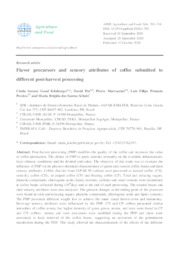Flavor precursors and sensory attributes of coffee submitted to different post-harvest processing.
Flavor precursors and sensory attributes of coffee submitted to different post-harvest processing.
Author(s): KITZBERGER, C. S. G.; POT, D.; MARRACCINI, P.; PEREIRA, L. F. P.; SCHOLZ, M. B. dos S.
Summary: Post-harvest processing (PHP) modifies the quality of the coffee and increases the value of coffee production. The choice of PHP to apply depends primarily on the available infrastructure, local climatic conditions and the desired end-value. The objective of this study was to evaluate the influence of PHP on the physico-chemical characteristics of green and roasted coffee beans and their sensory attributes. Coffee cherries from IAPAR 59 cultivar were processed as natural coffee (CN), semi-dry coffee (CD), de-pulped coffee (CP) and floating coffee (CF). Total and reducing sugars, phenolic compounds, chlorogenic acids, lipids, proteins, caffeine and water content were determined in coffee beans collected during (10thday) and at the end of each processing. The roasted beans and their sensory attributes were also analyzed. The greatest changes at the ending point of the processes were found in total and reducing sugars, phenolic compounds, chlorogenic acids and lipids contents. The PHP presented different weight loss to achieve the same visual brown color and luminosity. Beverage sensory attributes were influenced by the PHP: CN and CP coffees presented similar intensities of coffee aroma, but higher intensity of green grassy aroma, and taste were found in CF and CN coffees. Aroma and taste precursors were modified during the PHP and these were associated to husk removal of the coffee beans, suggesting an activation of the germination metabolism during the PHP. This study allowed the characterization of the effects of the different post-harvest processing on the roasted coffee beans and provides the foundations to monitor their efficiencies in the future.
Publication year: 2020
Types of publication: Journal article
Unit: Embrapa Coffee
Observation
Some of Embrapa's publications are published as ePub files. To read them, use or download one of the following free software options to your computer or mobile device. Android: Google Play Books; IOS: iBooks; Windows and Linux: Calibre.
Access other publications
Access the Agricultural Research Database (BDPA) to consult Embrapa's full library collection and records.
Visit Embrapa Bookstore to purchase books and other publications sold by Embrapa.

